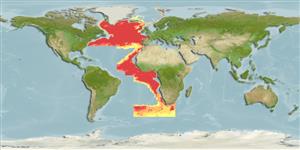Actinopterygii (ray-finned fishes) >
Ophidiiformes (Cusk eels) >
Bythitidae (Viviparous brotulas) > Bythitinae
Etymology: Thalassobathia: Greek, thalassa = the sea + Greek, bathis, -idos = a sting ray (Ref. 45335). More on author: Cohen.
Environment / Climate / Range
Ecology
Marine; bathypelagic; depth range 500 - 1000 m (Ref. 50610). Deep-water, preferred ?
Eastern Atlantic: two specimens between Ireland and Iceland (Ref. 4758) and one from the Gulf of Guinea; reported from Greenland (Ref. 9925) and Iceland (Ref. 12462). Northwest Atlantic: Georges Bank. Identification of specimen reported from the Bering Sea uncertain (Ref. 34024, 45907).
Size / Weight / Age
Maturity: Lm ? range ? - ? cm
Max length : 22.1 cm SL male/unsexed; (Ref. 6526)
Uncommon species, living in close association with the large jellyfish, Stygiomedusa sp. (Ref. 34024).
Life cycle and mating behavior
Maturity | Reproduction | Spawning | Eggs | Fecundity | Larvae
Nielsen, J.G., D.M. Cohen, D.F. Markle and C.R. Robins, 1999. Ophidiiform fishes of the world (Order Ophidiiformes). An annotated and illustrated catalogue of pearlfishes, cusk-eels, brotulas and other ophidiiform fishes known to date. FAO Fish. Synop. 125(18):178p. Rome: FAO. (Ref. 34024)
IUCN Red List Status (Ref. 115185)
CITES (Ref. 94142)
Not Evaluated
Threat to humans
Harmless
Human uses
Fisheries: of no interest
More information
ReferencesAquacultureAquaculture profileStrainsGeneticsAllele frequenciesHeritabilityDiseasesProcessingMass conversion
Tools
Special reports
Download XML
Internet sources
